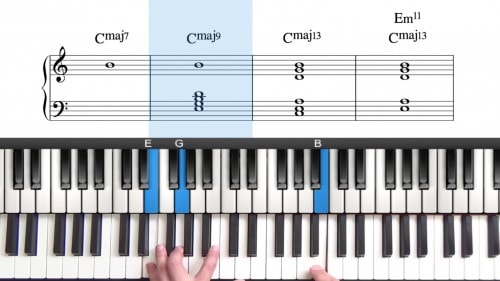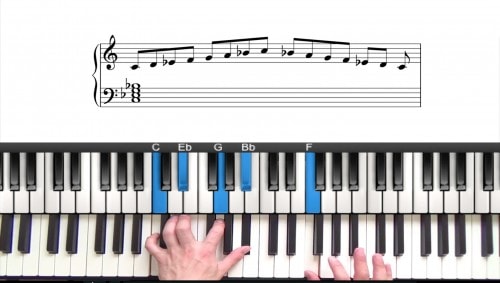How To Learn & Memorise Voicings
Learning and memorising chord voicings is an important skill for the jazz pianist. This will allow you to read and interpret lead sheets and create full-sounding jazz piano arrangements.
In this lesson, we use the 3 voicing from this course as examples:
- The "So What Voicing"
- The "Herbie Hancock Voicing"
- The "Kenny Barron Voicing"
Using these common voicing shapes, we explore the key drills and exercises that you should do for any voicing that you like the sound of.
Exploring Inversions & Re-Arranging The Notes
We all have different sized hands which means that some of us might find it tricky or easy to voice chord in certain positions, and certain keys.
In this lesson, we will explore and demonstrate simple variations that you can apply to any chord voicing to make it easier to play. Some simple advice is to re-arrange the notes within the space on an octave.
Remember that the extensions can be placed anywhere in the chord, so you have the creative freedom to choose the order and arrangement of the notes you play.
Memorise The Top Note Of The Voicing
The key with learning voicings is to memorize the top note or melody note. For example, the "So What Voicing" has the 5th on top, the "Herbie Hancock Voicing" has the 9th on top, and the "Kenny Barron Voicing" has the 11th on top.
That means that whenever you see a minor chord on a lead sheet with that scale degree in the melody, you will immediately have a chord that you know will work well.
Before long, you will see the chord symbol and the melody note, and your hands will instantly gravitate towards certain voicings, and that’s a nice point to get to.
By attempting to arrange your own jazz standards, you will retain the information much better. By all means, watch and enjoy the PianoGroove jazz standard tutorials, but remember to explore other songs that interest you.
This is a gradual process and it may take months to create a nice arrangement so just chip away at it a little each day and remember to listen to lots of recordings of the tune you are trying to arrange.
Lesson Downloads
-
Chord Extensions Practice Plan File Type: pdf
Practice Tips
-
Memorise the construction of your voicings in terms of scale degrees. This gives you the ‘formula’ or ‘blueprint’ to construct in all keys.
-
Transpose your voicings through all 12 keys which you can do chromatically, around the circle of fifths, and just at random to test yourself.
-
Apply your new voicing in the context of the 251 progression so that you are ready to use it in the tunes you are playing.
- Flick through your fake book and look for opportunities to apply your new voicing. Look for the chord quality with the same scale degree in the melody as the top of the voicing.







9:40 that was a bit depressing lol.Jokes aside exellent content as always.
Awesome
Great teacher, great pedagogy ! I have a hard to make my fingers able to remember eveything, but I am so happy with the results :)
Thanks Alain, glad you are finding the course useful.
It takes time to memorise the voicing shapes so do be patient with it. Consistent daily practice is the key and you will see guaranteed improvement with these exercises.
Here to help if you have any further questions.
Cheers,
Hayden
Best way to learn jazz at home during the pandemic. Awesome!
Question. You showed the 251’s for each, but examples are not listed in the practice plan. It made perfect sense as I watched you do it, but, for example, going back through taking the “so what” chord through the 251’s will probably be difficult to remember what to do by tomorrow. :) Same thing with the “Herbie Hancock” and the “Kenny Barron” voicings. I have practiced the voicings and know how to find them easily, but remembering where to go with the 251’s will be a challenge. Is there any chance we could get a quick pdf with an example of each? Thank you thank you!
?? Please??
Hi Branson,
Apologies for the late reply and yes I can certainly create that PDF for you. I think it’s an awesome idea and will help to make the lesson points more understandable and actionable.
I will get it done this weekend and send you a message once it’s uploaded.
Cheers,
Hayden
Thank you! I’m really excited to have this. You’re awesome.
My pleasure Branson.
I am in the process of creating a new late-beginner course which will be finished this month and it covers exactly what you are asking for here, so it’s great timing.
I’ve been crazy busy with admin and website changes the last few weeks but my schedule is getting back to normal now.
I will send over the PDFs for your perusal before publishing them to make sure it’s exactly what’s needed.
Cheers,
Hayden
Hi Branson,
Just to let you know I have not forgotten about this. I recorded a couple of lessons over the weekend and I am editing them now. The 1st lesson shows voicings for all chords in C Major, and the 2nd lesson shows the different ways to voice 251s using different ii-7 chord starting points.
The lessons and PDF downloads will be ready this week.
Cheers,
Hayden
Hi Hayden,
For me too it’s very difficult to memorize all the chord voicings. The PDF would help a lot.
I love very much the way you are teaching.
Thank you.
Mona
Wouldn’t it be easier to renounce the designations „9,11,13“, because it is the same as „2,4,6“? We could say also „16,18,20“, depending on the position on the keyboard. But it makes no sence because it is all the same.
Best regards, Jochen
Hi Jochen,
Good question.
The rule to remember is that if the 7th is present, the “2” becomes the “9”. For example if we play a C major triad and add the 2nd note, this chord is called “Cadd2”, whereas if the 7th is present, the chord would be Cmaj9. The reasoning is that the chord extensions are built on top of the 7th.
Try for yourself… The sound is very different if you play Cadd2 (Cmajor traid with the 2nd note) or Cmaj9 (Cmaj7 with the 9th). The latter has a richer sound.
To give you some other examples:
If we have the notes C-E-G-A – this would be C6.
If we have the notes C-E-G-A-D – this would be C69
If we have the notes C-E-G-B-D-A (voiced in any configuration, it doesn’t have to be sequential like this) it would be Cmaj13, because when the 7th is present, the 6th becomes the 13th because we are building higher than the 7th. If you remove B from this voicing, we have C69.
The rule to remember is “if the 7th is present, then the 2/4/6 becomes 9/11/13”. Following your logic, there would be no way to distinguish (in written/spoken language or chord symbols) between the sounds of C69 and Cmaj13, as an example. Using your approach, both of these chords would be C69, but the sound is very different when the 7th is included ie. Cmaj13.
Regarding 16/18/20, this is not possible because when we stack another 3rd on top of the 13th, we are back to the root. So the 13th is the highest possible extension and then the pattern starts again.
Think C(R)-E(3)-G(5)-B(7)-D(9)-F(11)-A(13) and if we stack another 3rd on top of A we come back to C which is root and cycle starts again.
C-E-G-B-D-F-A-C-E-G-B-D-F-A-C etc…
The position on the piano is irrelevant, if the 7th is present, the 2 becomes the 9, and the 6 becomes the 13th. The 4/11 is a little different because we don’t play it over major chords, but if we use the #11 which is very common in major and dominant chords, then the same logic applies:
Cmaj13#11 would be = C-E-G-B-D-F#-A
C69#11 would be = C-E-G-D-F#-A (this can be seen as a bi-tonal voicing as we are playing a C major triad in our left hand, and a D major triad in our right hand. By inverting the triads in each hand we can discover a myriad of voicing possibilities)
The above is simply how extended chords are referred to and classified in jazz. Sometimes it can be confusing I agree, but this is how extended chord theory works.
Please let me know if you have any more questions with this.
Talk soon,
Hayden
Helpful description of jazz chords Hayden. I often don’t know where I’m supposed to put the 6th note when Isee say an Eflat 6 or G6 when voicing the chords. Is it sort put where it sounds best? Is there a formula when I see it in the Real Book often at the end of a song.
An aside, have you listened to Keith Jarrett’s version of Then I’ll Be Tired of You on YouTube? Love the intro. Maybe you could add this to our list of songs to work on. I don’t have this song in my Real Book but am tryin to figure it by ear.
?si=fDyZCkuQd_-0AG6A
Thanks
Eric Howland, Los Angeles
Hi Eric,
Please excuse my late reply here.
Yes typically the 6th will be voiced somewhere in the middle of the chord (in between the root and the melody note). The 6th will either replace the 7th – usually at the end of a song as you point out – or it will be played in addition to the 7th and the 6th then becomes the 13th of the chord. That’s an important rule to remember… “if the 7th is present in the chord, we view the 6th note as the 13th, because it is then seen as an upper extension”.
For the formula, just think root in the left hand, melody with the right hand pinky, and the 3rd and 6th somewhere in between. Usually there will only be 2 or 3 possible options here so you can follow your ears on what sounds best. This is the same process as creating a spread voicing with the root, 3rd, and 7th that we explore in our Novice jazz standard arrangements.
Please let me know if you have any further questions here.
Thanks for sharing this lovely recording and yes we can certainly explore this tune in a lesson or seminar. I have added it to our upcoming lesson schedule.
That’s great.
It can be a slow process learning to play a song by ear so do be patient and just spend 10 or 15 minutes working on it each day.
You can also spend a little time each day on the ear training exercises (again just 10 or 15 minutes) to develop your listening and transcription skills: pianogroove.com/exercises/
Talk soon,
Hayden